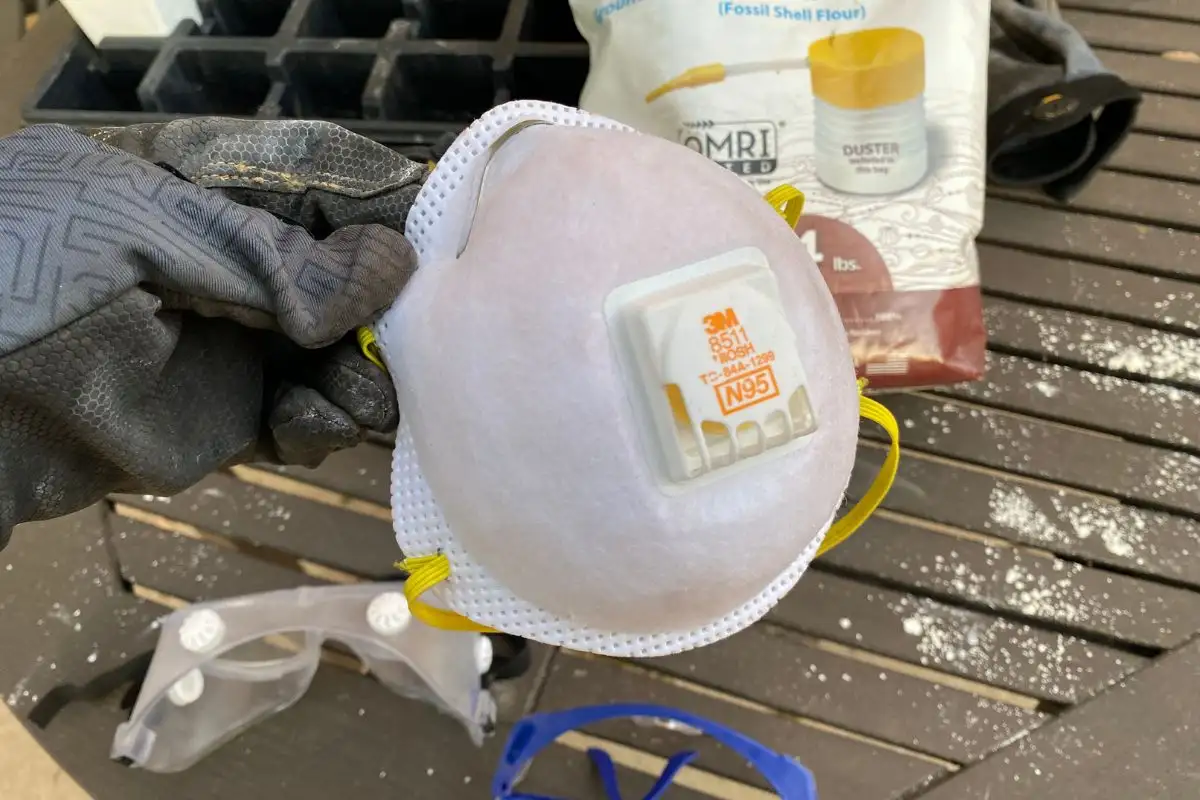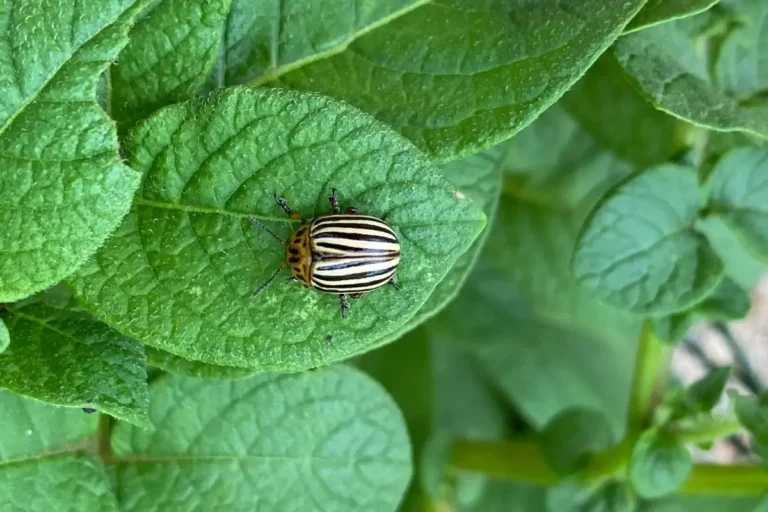Using Diatomaceous Earth: Do I Need to Wear a Mask?
When I first started using diatomaceous earth (DE) in my garden, I had a lot of questions. One of the most pressing was whether or not I needed to wear a mask when applying it. After all, DE is a fine powder that can easily become airborne, and I didn’t want to risk inhaling it.
You might be asking yourself the same question: Do I need to wear a mask when using DE?
Whether inside or outside, the safest way to apply diatomaceous earth is to do so while wearing a mask to avoid accidentally inhaling airborne DE particles. Both N95 and KN95 masks will prevent DE inhalation. For additional safety, use protective eyewear to prevent eye irritation on windy days.
Generally speaking, diatomaceous earth is safe to use around the home and garden since DE is a natural substance that’s harmless to the touch yet potent when it comes to pest management.
However, if you inhale DE, you might irritate your lungs, especially if you inhale significant amounts of it. This is especially true if you’re applying it in a confined space or outside on a windy day.
In this article, I’m going to look at several important matters when it comes to applying diatomaceous earth safely and effectively:
- why you should consider masking up (even if it’s not windy)
- 5 easy steps to avoid DE inhalation and irritation
- what happens if you accidentally inhale DE particles
- what to consider when handling DE
Handling Diatomaceous Earth Safely: Mask or No Mask?
When it comes to handling diatomaceous earth either inside or outside, you’ll want to take some safety precautions to protect your health.
One of the most common questions that gardeners ask is whether or not they need to wear a mask when using DE. For me, the answer is usually “yes” since DE is so powdery it’ll blow all over the place if there’s even the slightest wind outside.
To determine whether wearing a mask is necessary, you should consider a few factors. First, evaluate the scale of your DE application. If you’re working with very small amounts indoors or in well-ventilated areas, you might not need a mask. However, for larger outdoor applications or if using DE in confined spaces, I highly recommend wearing a mask.
Additionally, you should also take into account your personal sensitivity to dust and your comfort level when working with fine powders. Some people may be more susceptible to respiratory irritation and may benefit from wearing a mask regardless of the application scale.
The first time I applied DE, I didn’t know what I was doing. I loaded up a cheap plastic bulb duster, aimed it at an infested tomato plant, and pressed down hard.
Sure enough, a cloud of DE came out at the end of the duster, and a slight wind outside caused all of it to blow back in my face.
I quickly closed my eyes and ran in the opposite direction, but that one experience was enough to teach me never to do THAT again!
Long story short, whenever you’re applying DE, slip on an N95 or KN95 mask before doing so. In fact, I have a KN95 mask that hangs in my garage for just this reason.
Make sure the mask fits snugly over your face, then get to work with your DE. Your lungs will thank you!
One final thing: Beyond an N95 or KN95 mask, you should also consider wearing 2 other protective items:
- Goggles or Protective Eyewear: Much like your lungs, your eyes will get irritated if you’re working with DE and those particles get in your eyes. Glasses aren’t going to offer much protection since DE particles easily blow around them, so you should instead get a cheap pair of goggles. They’re not all that comfortable, but they work perfectly!
- Gloves and Long-Sleeved Shirts: Because DE is powdery, it’ll get all over your hands if you’re handling it without gloves. I slip on a pair of gloves—the kind of glove doesn’t matter at all—before I work with DE. I’ll even put on a long-sleeved shirt for extra protection. That way, once I’m done, I simply remove my gloves and change shirts, and I’m good to go!
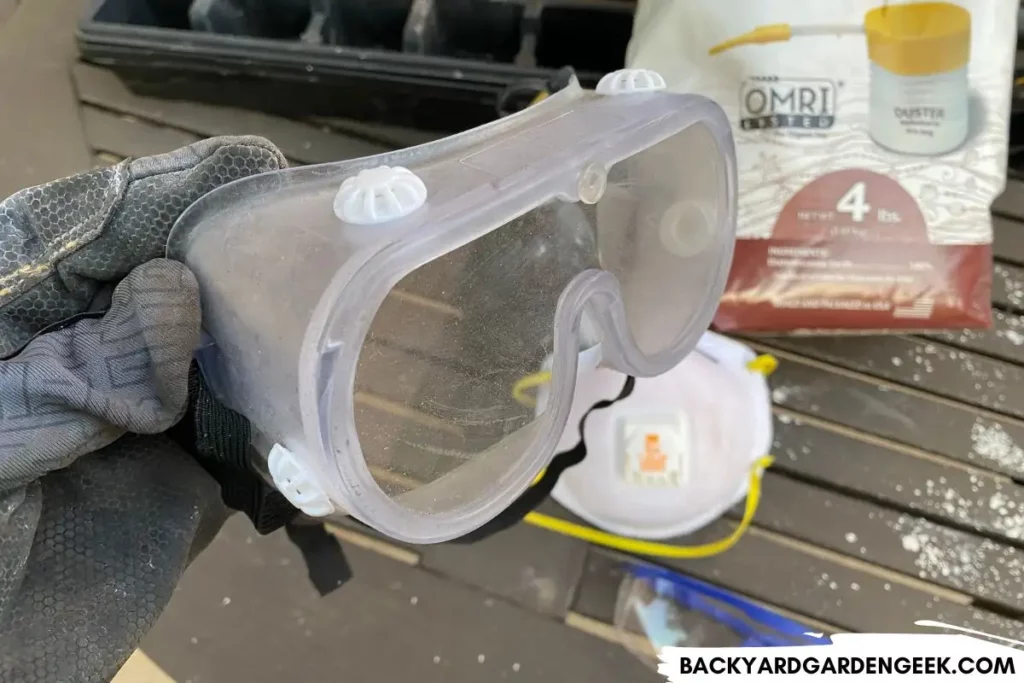
Also, please note that not all DE products are created equal. Make sure you’re using “food-grade” DE whenever you’re working in your garden since that’s safe for use around plants and pets.
Some “filter-grade” DE products are designed for use in swimming pools or industrial settings, and those may contain harmful chemicals or additives. Definitely don’t use that kind of DE around your home or garden!
Remember, wearing protective gear not only helps protect your respiratory system but also reduces the likelihood of irritating your eyes and skin. If you’re going to experiment with DE, please err on the safe side until you’ve got lots of experience working with DE powder.
How Not to Inhale Diatomaceous Earth: 4 Simple Steps
Whatever you’re planning to do with your DE, I want to share some practical tips on how to handle it safely:
1. Wear a Mask
As I noted above, masks are the safest way to go when it comes to applying DE. It takes little to no time to put one on, and you’ll ensure that your lungs are protected in case a breeze causes the DE to blow back in your face.
Even if you can’t find any N95 masks for sale, you should be able to find KN95 masks (or something equivalent). Designate one of those as your DE-only mask, and store it after every use. You can use the same mask multiple times before you need to replace it.
2. Use a Quality Bulb Duster
Instead of applying DE directly from the bag, use a dusting bulb instead. This helps control the dispersion of dust and reduces the chances of inhaling airborne particles.
Bags of Harris diatomaceous earth will often come with plastic dusting applicators, and those work okay. But I prefer Dr. Killigan’s bulb duster for all of my DE applications. It’s a high-quality bulb duster, and it makes applying DE much easier and more efficient.
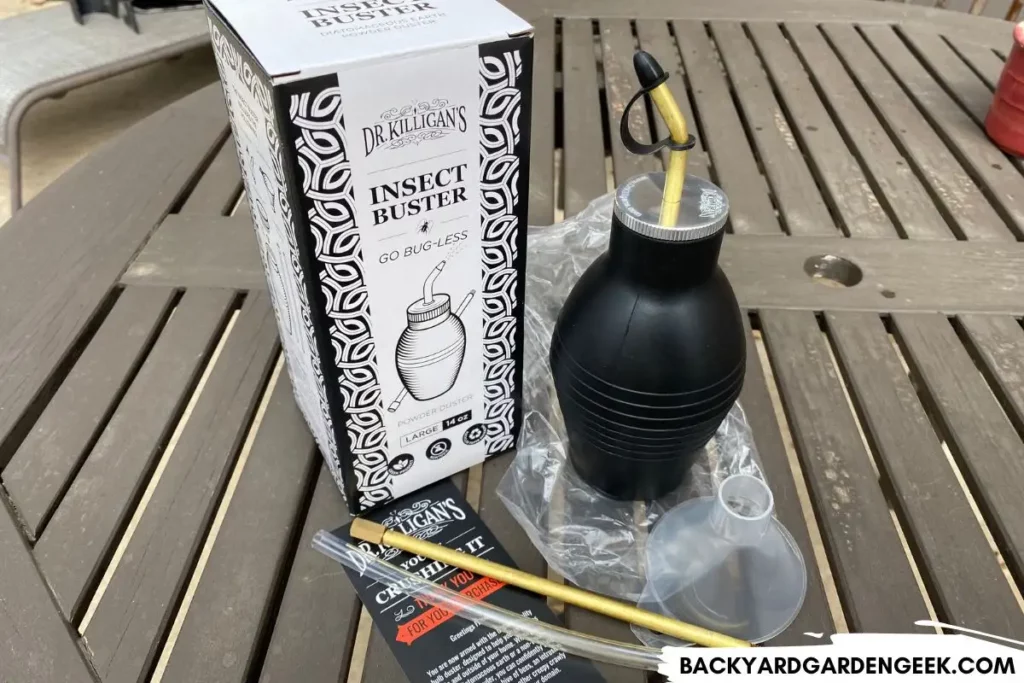
3. Apply Carefully and Consistently
To prevent excessive dust, apply DE in a gentle and controlled manner. Avoid creating large clouds of dust by using a plastic applicator or bulb duster when dusting affected areas.
Never apply DE on windy days. Even slight winds will blow that powder all over the place.
Instead, wait for days that aren’t all that windy, especially if you can dust your plants in the early evening when helpful pollinators have mostly stopped flying around for the day.
4. Work in Well-Ventilated Areas
Good ventilation is crucial during DE applications, especially if you’re using DE to treat pest problems indoors.
If you’re working indoors, open windows (if it’s not a windy day) and keep all of your doors open. Exit the room for a few minutes after the application to ensure that you’re not surrounded by any lingering airborne particles.
When working outdoors, this is less of an issue since you’ve got plenty of space. Just avoid windy days, and you’ll be fine!
5. Wear Additional Protective Gear
As I noted above, the best way to protect yourself during DE applications is to wear a nice tight-fitting mask, protective goggles, and gloves. You might feel a little silly at first, but it’s far better to feel silly than to get DE in your eyes, nose, or mouth!
You can even wear pants and a long-sleeved shirt to minimize skin contact.
By following these practices, you can greatly reduce the risk of inhaling diatomaceous earth.
Remember, it’s always better to err on the safe side and take the necessary precautions to ensure your safety when working with diatomaceous earth in your garden or home.
What Happens If You Inhale Diatomaceous Earth?

If you inhale diatomaceous earth in small amounts, you don’t need to worry. Just make sure you get to a well-ventilated area—or run away from whatever DE cloud you’ve spraying in your garden—and everything should be just fine.
As I shared above, this happened to me, and I didn’t notice any problems whatsoever despite DE blowing directly into my face.
Unfortunately, excessive inhalation of DE particles can cause respiratory irritation and discomfort.
Symptoms of excessive inhalation may include coughing, throat irritation, shortness of breath, and nasal congestion. These effects are typically temporary and subside once your exposure to DE particles is reduced or eliminated.
However, individuals with pre-existing respiratory conditions or allergies may experience more severe symptoms and should contact a licensed medical professional.
(Better yet, just wear a good mask, good goggles, and good gloves, and you won’t have to worry about any excessive inhalation of DE!)
If you inhale a significant amount of DE or experience persistent respiratory discomfort, seek out medical attention.
To minimize the risk of inhaling DE, follow my advice above and wear a mask, put on goggles, and slide on a good pair of gloves.
By taking these precautions, you can significantly reduce the chances of respiratory irritation associated with DE inhalation.
Should I Wear Gloves When Handling Diatomaceous Earth?
When it comes to handling diatomaceous earth, you should go ahead and protect your skin since you’re already safeguarding your respiratory health.
Simply put, wear gloves when handling DE. It’s so simple, and you’ll save yourself a headache (and possibly slight skin irritation) by doing so.
You can choose gloves made of nitrile, latex, or rubber as they offer excellent protection against DE particles, but I’ve found that just about any gardening glove works just fine when handling DE.
Avoid using fabric gloves you might wear during the wintry months since that kind of fabric is not great when it comes to gardening. Mechanics gloves work just fine since they’re designed for auto repair shops.
After handling DE, I recommend removing your gloves and washing your hands thoroughly with soap and water. This will help remove any residual DE and ensure that you don’t inadvertently transfer it to your eyes, nose, or mouth later on.
Simply put, if the gloves are appropriate for gardening, they’re likely also appropriate for handling DE. When working with diatomaceous earth, you might as well prioritize your safety to avoid any potential health risks..
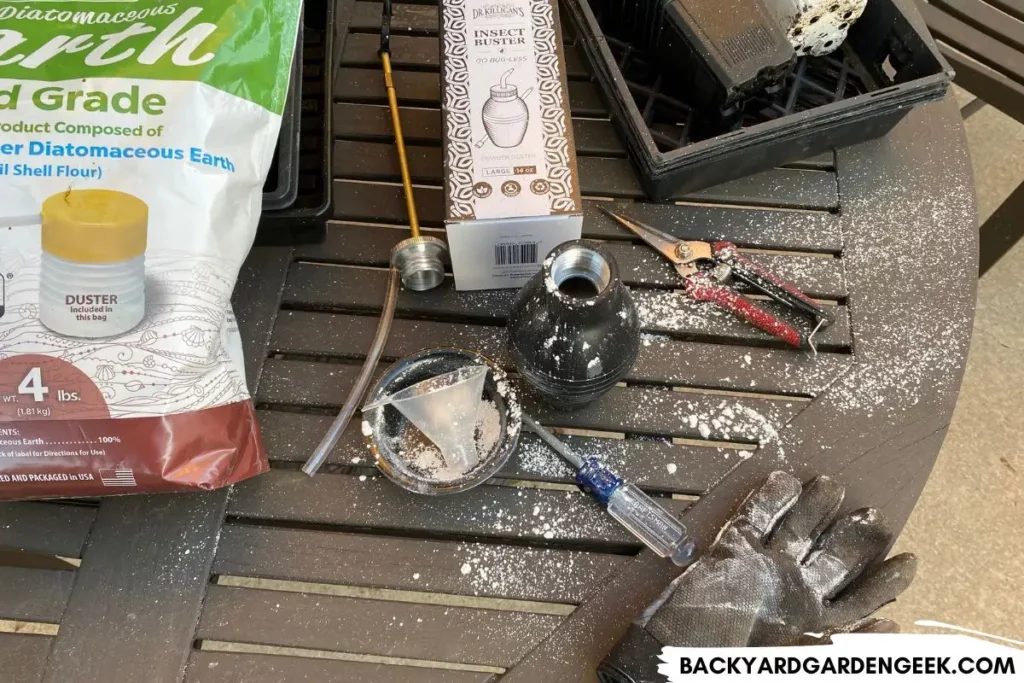
Whether or not you wear a mask during DE application depends on various factors such as the scale of application and your personal comfort level, but I suggest doing so each time so as to err on the safe side.
Keep in mind that individual sensitivities and circumstances may vary. It’s important to assess your own comfort level and take appropriate safety measures accordingly.
By handling diatomaceous earth safely and responsibly, you can enjoy its benefits as a natural pest control method while ensuring your and your family’s well-being.
Remember to be mindful of your specific circumstances, consult professionals when needed, and enjoy the benefits of a healthy and thriving garden with the help of a little diatomaceous earth!
Further Reading
If you’d like to learn more about my experiences using diatomaceous earth, check out these other DE-related articles:
- 5 Reasons to Mix Diatomaceous Earth with Soil
- Can Diatomaceous Earth Harm Plants? What Scientists Say
- Can You Put Too Much Diatomaceous Earth on Plants?
- Diatomaceous Earth and Ladybugs: Will DE Kill Them?
- Diatomaceous Earth vs. Neem Oil: Which Should You Use?
- Using Diatomaceous Earth as a Fertilizer: Will DE Help?
